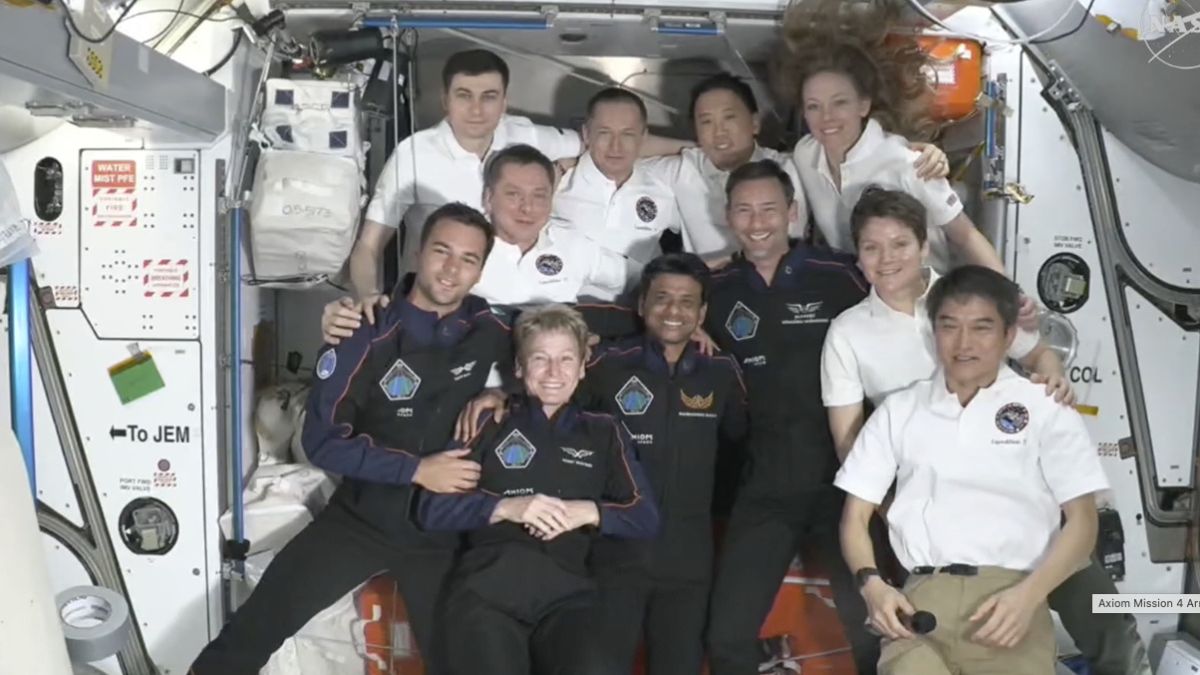Experiments in space: Axiom Mission 4 crew, including Shubhanshu Shukla, begin work at ISS

The Axiom Mission 4 (Ax-4) team—Commander Peggy Whitson, Pilot Shubhanshu Shukla and Mission Specialists Sławosz “Suave” Uznański-Wiśniewski and Tibor Kapu have been working actively on the International Space Station (ISS).
From the time of their launch on June 25 2025, the astronauts have been doing important experiments that could change the way we treat diseases, grow food, and use new technology both in space and on Earth. This mission is filled with scientific work that shows how space travel can actually help common people in their daily lives.
Recapping the journey so far, on June 26 2025, their second day in space, the crew reached the ISS at 5.53pm IST, after their spacecraft docked at 4.01pm IST. Once inside the station, they got settled, moved into their sleeping areas, and started getting ready for their experiments. Shukla, Suave, and Tibor, all going to space for the first time, shared their excitement during a live event, where they showed Earth as seen from above Europe. They also unpacked supplies and reviewed emergency safety steps so they would be ready for the busy days ahead.
By June 27, 2025, the team was fully set up on the space station and started working closely with the Expedition 73 crew, who were already living there. They trained on how to handle emergencies and how to work together. They also transferred important items like science samples and safety tools from their Dragon spacecraft to the station. They started setting up their lab equipment, preparing for the main science work coming next.
On June 28, 2025, their fourth day, the crew began their main science experiments. Peggy started the Cancer in LEO-3 study, which looks at how cancer cells, especially a dangerous type of breast cancer, behave in the zero-gravity conditions of space. “This experiment could help scientists find better treatments for cancer on Earth and also keep astronauts healthier on long missions.
Shukla, on the other hand, used a special glovebox to do the Myogenesis experiment, which studies how and why muscles become weak in space. A special glovebox is a sealed container with built-in gloves that astronauts use to safely handle sensitive experiments. It stops materials from floating away in zero gravity and protects both the astronaut and the experiment. The glovebox keeps the work area clean and controlled, which is very important when dealing with live cells, fluids, or delicate scientific tools,” explained space analyst Girish Linganna.
This work could help astronauts stay strong and also benefit elderly people or patients with diseases that make muscles weaker. On the same day, Tibor set up a device called the Rad Nano Dosimeter.
“This device measures the level of radiation inside the ISS—this is very important for planning safe trips to the Moon or Mars in the future. The information collected can also help build better tools to measure radiation in hospitals or areas hit by nuclear accidents on Earth,” remarked Linganna.
Tibor also began his Vitapric experiment, where he tested how to grow microgreens—small, healthy plants that are rich in nutrients. These plants can be a fresh food source for astronauts and may also help improve farming back on Earth.
On June 29 2025, the fifth day, the astronauts continued their science work. Shukla worked with microalgae, tiny organisms that are full of nutrients and could become an ideal space food for future long missions. Peggy continued the Cancer in LEO experiment, taking pictures of the cancer cells to understand how they behave in space conditions. Suave began his microfluidics experiment using a microscope to see how fluids move in space. The goal is to design small medical tools that can check if medicines still work in space.
The team also worked on a project called Neuro Motion VR. They used virtual reality headsets to study how the brain reacts in weightlessness—this helps us know how astronauts think and move in space. This research could help treat brain problems on Earth, too. They also started a study called Cerebral Hemodynamics using ultrasound machines to check how blood flows in the brain. This may help doctors on Earth diagnose and treat strokes and heart problems better.
Another project called Telemetric Health AI used smart technology to check the astronauts’ heart function and balance. This may lead to the creation of advanced health trackers for astronauts and for people on Earth.
Apart from their science work, the crew also inspired people across the globe. On June 28, Shukla spoke with India’s Prime Minister Narendra Modi, sharing the importance of space for bringing countries together. On June 29 at 4.45pm IST, Tibor had a call with Hungary’s Prime Minister Viktor Orbán, and later on June 30 at 9.50pm IST, he spoke live to Hungarian journalists, telling them about his experiences in space.
Peggy and Suave also spoke with a radiation scientist, and Peggy took photos of student science projects as part of a Saudi Space Agency competition to encourage young students to get interested in science and space.
As the Ax-4 mission goes on, it is clear that their work is not just about space. From fighting cancer to growing healthy food, from protecting astronauts to studying the brain, their research could help people all over the world.
Sci/Tech